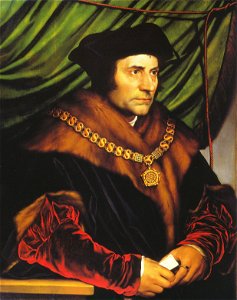Portrait of sir thomas more. Oak, 74. 2 × 59 cm. Frick collection, new york. Holbein arrived in england in late 1526 in search of work, bearing an introduction from the humanist scholar erasmus, for whom he had worked in basel, to his friend thomas more, the english lawyer, scholar, and statesman. Holbein was welcomed as a guest by more, who found him commissions and ordered various works from him, including a portrait of his family (the original is lost but a sketch and copies by other artists survive) and this portrait. According to art historian stephanie buck, more's chain, signalling his high rank, indicates that this was an official portrait. His black mantle, trimmed with sable, and red velvet sleeves testify to the sitter's wealth. Buck suggests that holbein's art advanced in this portrait, in which he uses single colours over large areas and intensifies the physical reality of the fabrics. Ellis waterhouse describes the uniqueness of the style: "except for the work of titian, nothing of the same senatorial dignity of presentation was being produced in european portraiture at this time, but the means—predominantly linear—are the exact opposite to titian's. The figure bulks largely in a clearly defined space whose cubical volume is deliberately reduced by a curtain; features, hands, and the carriage of the body are all used to convey character with equal effect, and the whole work has a shakespearian profundity and seems to convey the full image of a european personage". (stephanie buck, hans holbein, cologne: könemann, 1999, pp. 54–56; ellis waterhouse, painting in britain: 1530 to 1790, london: penguin, 1969, p. 18. ). Object Type: painting. Genre: portrait. Date: 1527. Dimensions: height: 74.9 cm (29.4 in) ; width: 60.3 cm (23.7 in). Medium: oil on oak panel. Depicted People: Thomas More. Collection: The Frick Collection. Sir Thomas More, by Hans Holbein the Younger
Loading...
